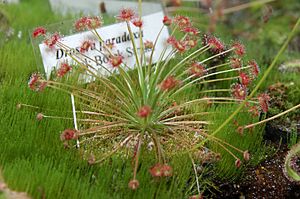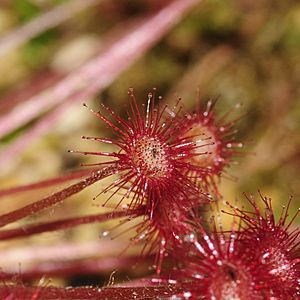Drosera paradoxa facts for kids
Quick facts for kids Drosera paradoxa |
|
|---|---|
 |
|
| In cultivation | |
| Scientific classification | |
| Genus: |
Drosera
|
| Species: |
paradoxa
|
Drosera paradoxa is a fascinating carnivorous plant that catches insects. It belongs to the Drosera group, also known as sundews. This plant is found only in specific parts of Northern Territory and Western Australia. It's a perennial plant, meaning it lives for more than two years. It grows like a small herb with a woody stem.
Contents
About Drosera paradoxa
This unique plant can grow up to 30 centimeters (about 12 inches) tall. Its leaves form a single group, called a rosette, at the top of the stem. These leaves can stand upright or spread out as the plant gets older. They are held on long, thin stalks called petioles, which are usually about 20–35 mm (around 1 inch) long when the plant flowers.
The actual carnivorous leaves are small and roundish. They are only about 2.5–3 mm (about 1/10 inch) wide and 2–3 mm (about 1/10 inch) long. These tiny leaves are covered in sticky dew-like drops that trap small insects.
Flowers of the Sundew
Drosera paradoxa produces flower stalks, called inflorescences, that can be 20–40 cm (about 8–16 inches) long. These stalks hold many pink or white flowers. The flowers grow in crowded clusters called racemes. You can see these beautiful flowers from July to September. This is during the dry season in Australia.
Where Drosera paradoxa Lives
This sundew plant likes to grow in sandy soils. It prefers areas over sandstone rocks. You can often find it in or along the banks of creeks that dry up during certain times of the year. It also grows in cracks in sandstone.
During the wet season, from March to April, the places where Drosera paradoxa lives often get flooded. Fast-flowing water covers its habitat.
Its Home in Australia
Drosera paradoxa is native to the western and northern coasts of the Kimberley region in Western Australia. It can be found inland to Beverley Springs. Eastward, it reaches Arnhem Land and Kakadu National Park in the Northern Territory.
How it Was Discovered
The Australian botanist Allen Lowrie first described Drosera paradoxa in 1997. He wrote about it in a science journal called Nuytsia. This journal is published by the Western Australian Herbarium.
A Puzzling Plant
The name paradoxa comes from the word "paradox." This is because early observations of the plant were confusing. Some groups of these plants seemed to be annual, meaning they lived for only one year. New seedlings would replace the older, woody plants. Other groups had no woody stems at all. Yet others were tall and mature.
It took several trips into the field, from 1993 to 1997, to solve this mystery. Scientists realized that these different forms were just stages in the plant's life. Drosera paradoxa is a perennial plant. It goes through a cycle from a tiny seedling to a basal rosette (a flat group of leaves). Then it grows into a tall, woody-stemmed plant.
The first official sample of this plant, called the type specimen, was collected on August 1, 1996. It was found near Wren Creek in Western Australia.
Conservation Status
In 1997, Allen Lowrie said that Drosera paradoxa was common. He believed it was not in danger of disappearing.
This plant is closely related to another sundew, D. petiolaris. However, Drosera paradoxa is different because it grows a tall, woody stem. D. petiolaris forms clumps of many rosettes from a shared root system.
See also
 In Spanish: Drosera paradoxa para niños
In Spanish: Drosera paradoxa para niños


